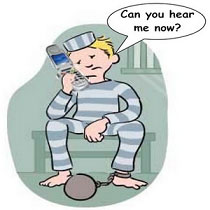 The American Correction Association has an article on its website summarizing the recent meeting of the newly-formed No Cells in Cells Coalition on Oct. 23, 2012, at the ACA headquarters to discuss the problem of contraband cell phones smuggled into prisons. Attendees included representatives from the Delaware Department of Corrections, the Maryland Department of Public Safety and Correctional Services, the Virginia Department of Corrections, the American Jail Association, the National Organization for Victim Assistance, the National Sheriff’s Association, cell phone companies Sprint and ATT, the Federal Bureau of Prisons and others.
The American Correction Association has an article on its website summarizing the recent meeting of the newly-formed No Cells in Cells Coalition on Oct. 23, 2012, at the ACA headquarters to discuss the problem of contraband cell phones smuggled into prisons. Attendees included representatives from the Delaware Department of Corrections, the Maryland Department of Public Safety and Correctional Services, the Virginia Department of Corrections, the American Jail Association, the National Organization for Victim Assistance, the National Sheriff’s Association, cell phone companies Sprint and ATT, the Federal Bureau of Prisons and others.
According to the article, the attendees discussed the types of offenders most likely to attempt to smuggle phones. “Members concluded that while phones are more likely to be smuggled by long-term offenders looking to continue their drug or crime operations, witness intimidation within pretrial facilities is common as well. Kristy Dyroff, director of communications for the National Organization for Victim Assistance, commented that witness intimidation through use of cell phones in pretrial facilities is most common in domestic violence cases.
Several methods currently used to combat the issue of contraband cell phones were discussed throughout the meeting, including:
• Dogs trained to sniff out cell phone parts;
• Technologies such as managed access;
• Thorough searches and seizures by correctional staff;
• Metal detectors; and
• Observation and profiling to determine which offenders are most likely to
smuggle phones.
Though each method has its benefits and downsides, according to Judi Garrett, assistant director of the Federal Bureau of Prisons, no single method has been proven significantly more effective than the others.”
We fully support the initiatives recommended by this coalition. Yet what is interesting about this list is that all the measures being contemplated are supply side solutions. There seems to be no thinking on how to address the demand side of this issue however…
Interestingly, another recent blog posting, this one from Marcus Spectrum Solutions, discusses the recent decision by the FCC to take up the Wright Petition on high prison long distance rates and the impact these rates have had on driving the demand for contraband cell phones. The title of the post is “Telecom Policy Lessons from the War on Drugs.”
In the article, the author states, “A key lesson from the War on Drugs is that one must work both the “demand side” and “supply side” of these intractable problems to make progress. Short of having a total police state one just can not eliminate antisocial products that are in high demand.”
Clearly, there is nothing closer to a pure police state than a federal or state correctional facility, yet cell phones remain a significant problem in these facilities. The formation of the No Cells in Cells Coalition is proof of the challenge and size of this issue. And, as the author states, the reduction of the high long distance (interstate) rates common in many states may address some of the demand for contraband cell phones.
We believe however that the problem of demand for smuggled mobile phones in jail goes beyond long-term offenders looking to continue their drug or crime operations, witness intimidation and the avoidance of high LD rates. The demand is also driven by a desire for more communication and more privacy (not secrecy) and as such, any comprehensive solution should address both sides of the equation – supply and demand.
- Blockchain System for Compliant Inmate Transactions - March 4, 2025
- Securus Gets the Signal, Eleven Years Later - August 23, 2024
- Multi-Blockchain System for Inmate Forensics - April 2, 2024




